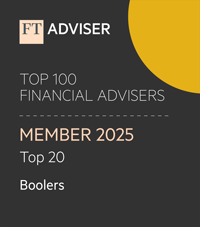Reveal Menu
Market Commentary: Monthly Bulletin April 2024

Prabhdeep Gill









We start our commentary by highlighting the performance of the main equity indices over the month, as shown below.
(All figures are based on bid-to-bid pricing with income reinvested, in Sterling terms)
High for Long or Higher for Longer?
This month latest figures showed the US economy grew at an annualised rate of 1.6% in the first quarter of 2024 vs 3.4% in the fourth quarter of last year. In theory, this is what the doctor ordered, the Federal Reserve (Fed) wanted to raise rates to slow down the economy to bring down inflation. However, the problem is that inflation continues to be sticky and appears to be moving away from the Fed’s target rate of 2%.
The ‘last mile’ of inflation is a problem for the Fed even though economic growth may be slowing, interest rates cannot fall until the fed see’s clear signs of sustainable slowing inflation. This potentially changes the narrative in markets from ‘higher for longer’ to ‘high for long’, meaning interest rates will roughly stay where they are as the new normal because this is required to keep the economy at equilibrium in terms of achieving stable economic growth, in a slightly higher inflationary world.
For markets the implications of ‘high for long’ does not mean equities cannot outperform. Fundamentals of companies are still very good due to strong balance sheets and earnings continue to remain resilient. For example, Q1 2024 earnings season has been good with, 77% of S&P 500 companies so far having reported a positive EPS (Earnings Per Share) surprise.
In our view, investors should focus on active stock picking with an emphasis on looking for quality companies at very reasonable prices to navigate such an environment.
FTSE 100 Reaches All Time Highs
The FTSE 100 closed at a new high of 8,147 on the 29th of April, driven by enthusiasm around interest rate cuts. While investors have consolidated some gains in highly valued tech sectors in the US, the FTSE 100 has quietly been gaining traction thanks to its heavy mining and energy weighting which has benefited from the strength in oil, copper, and precious metals.
In addition, the recent equity market volatility and geopolitical risks have prompted investors to buy defensive stocks. This has led to a concentration in the UK blue chip index with the likes of BP Plc, BAE systems Plc, GSK Plc and Rolls Royce Holdings Plc all contributing around 80% of the gains so far.
This focus on the larger end of the UK market has also trickled down to medium and smaller companies, although not to the same extent. Our UK exposure remains diversified across the market capitalisation spectrum to take advantage of the long-term growth potential, particularly at the smaller end.
Small Caps – The Catch-Up Trade
It is no secret that global smaller cap companies currently trade at very attractive valuations when compared to their larger counterparts. The MSCI World Small Cap Equity Index currently trades at a 19% discount relative to the MSCI World Equity Index. The question remains as to why investors have not piled in to close this discount, especially when historically smaller companies have outperformed.
The answer lies in that higher interest rates effect smaller companies more because traditionally they have more leverage on their balance sheets. In addition, a higher discount rate (interest rate) used to discount a company’s future cash flows reduces the intrinsic value of companies.
The global economy is getting to a point where the European Central Bank, Bank of England and eventually the Federal Reserve will begin reducing interest rates and small caps have historically outperformed at the start of a monetary easing cycle.
We continue to review our portfolios to ensure we are well placed to take advantage of the current and future environment.
THE BOOLERS INVESTMENT COMMITTEE
“At Boolers, you know that things will be dealt with properly and professionally. A real safe pair of hands!”
“I have always found the quality of advice, technical knowledge and level of service is second to none. ”
“Thank you to all of you for such a wonderfully smooth transaction! Hope we can do it again some time.”
“Boolers provided excellent advice when we needed it most.”
“Boolers have provided myself, family and business with pension and investment advice for over 30 years and continue to provide a high quality professional service to us all on an ongoing basis.”
“Chris Ball has been our Financial Adviser for many years and, from the start, we have been impressed with his strategic sense, his deep knowledge and his skills in helping us build our own successful retirement. He understands our aims and how to achieve them and has taken great care of us throughout. ”



